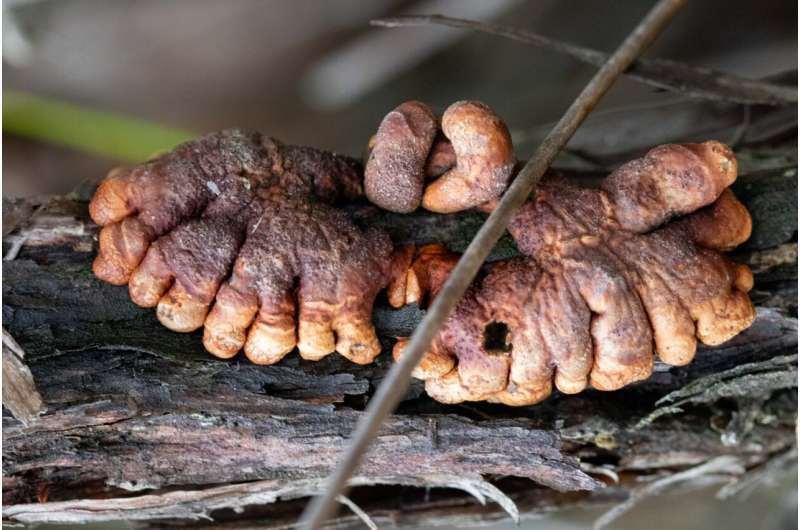Australia's rarest fungus discovered clinging to life on French Island

Scientists and volunteers from Royal Botanic Gardens Victoria have discovered the largest population of Australia's oddest and most critically endangered fungus on French Island, Victoria. Tea-Tree Fingers (Hypocreopsis amplectens) is named for its distinctive, finger-like form that seemingly grips its wooden substrate like a hand.
Tea-tree Fingers typically occurs at low densities within its narrow distribution on mainland Australia and is threatened with extinction by fire and unsuitable land-management practices. Until last week, the species was known to occur at only three small sites along the eastern coast of Western Port Bay, and one at Launching Place, where fewer than 20 individual fruit bodies were known to scientists.
However, on the first day of the expedition which aimed to find comparable habitat for this distinctive fungus, the team of 16 naturalists, led by Drs Michael Amor and Sapphire McMullan-Fisher, discovered a new population of nine distinct fruit bodies.
And further foraging by Gardens' Horticulturist, Penny Evans, during a lunch break, led to the discovery of the largest-ever recorded population of Tea-tree Fingers, which may contain over one hundred individuals—more than all previous observations made on the mainland, combined.
"Critically, this is the only existing Tea-tree Fingers population within a protected National Park. Three out of four mainland sites have uncertain futures as they are adjacent to sand mines," states Dr. Amor, "The relatively high abundance of Tea-tree Fingers on French Island may reflect the undisturbed nature of this comparatively pristine area and could offer insight into the historical state of mainland populations—that is, before human driven disturbance and habitat loss."
Tea-tree Fingers require large areas of long-unburnt habitat, the presence of a symbiotic fungus that it is believed to feed upon, and continual availability of freshly fallen wood material for its host to grow on. Climate driven warming and drying, along with bushfires, coupled with land clearing for development, as well as sand mining in the Nyora area, is rapidly reducing and fragmenting the little remaining Tea-tree Fingers habitat, which is a major threat to its existence.
"The discovery of protected areas of Tea-tree Finger's habitat on French Island greatly improves the prospect of the species' survival into the future," adds Dr. McMullan-Fisher. "This discovery also raises interesting questions about the dispersal mechanisms for Tea-tree Fingers, including how it traversed a 2–5 km stretch of ocean."
As a result of these findings, French Island is now regarded as the species' stronghold and its National Park status will hopefully provide some insurance against the increasing likelihood of Tea-tree Fingers' extinction on the mainland.
The team are keen to explore further areas across French Island and Gippsland in search of this unusual organism, with further surveys planned for the near future.
Provided by Royal Botanic Gardens Victoria


















